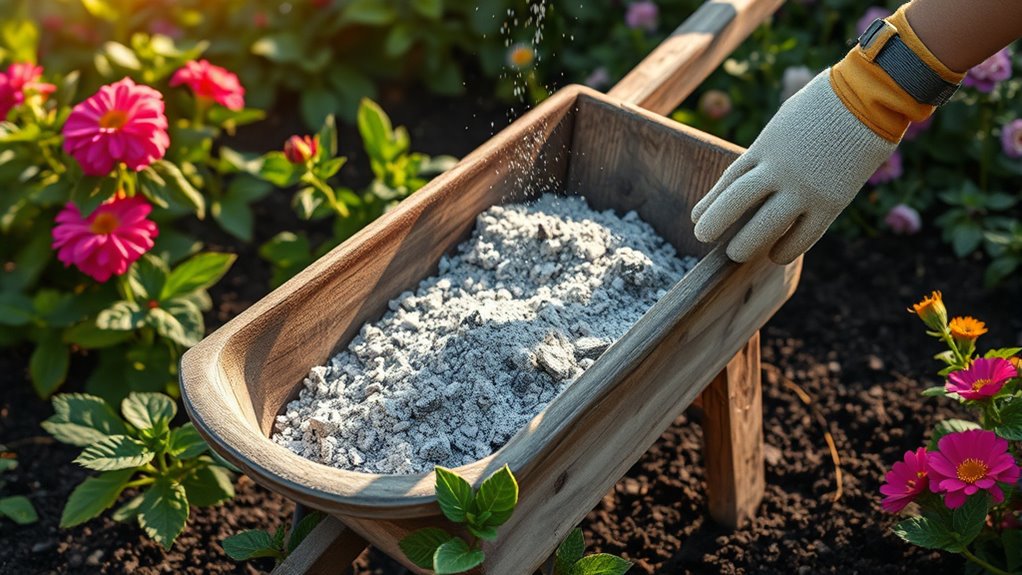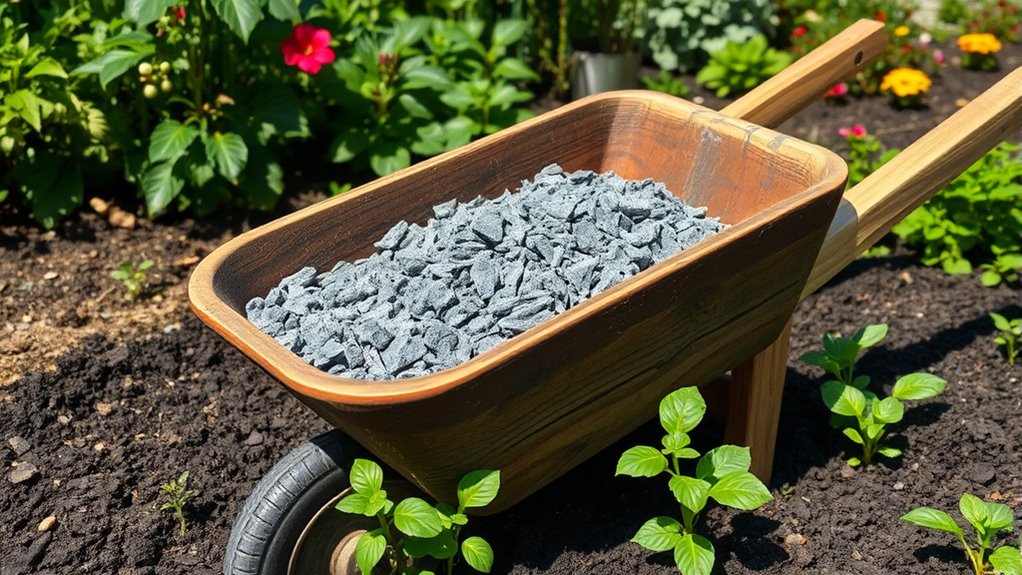Using wood stove ashes in your garden can provide essential nutrients like potassium, calcium, and magnesium, which boost soil fertility and plant growth. Apply a thin layer around plants or mix it into your soil, but be careful not to raise the pH too much, especially in acidic soils. Always test your soil first and use only untreated, natural wood ash. To discover tips on safe and effective ways to recycle ash, keep exploring the options available for sustainable gardening.
Key Takeaways
- Use untreated, natural wood stove ash only, avoiding painted or chemically treated wood.
- Apply a thin layer of ash around plants or mix it into soil to add nutrients.
- Test soil pH regularly to prevent excessive alkalinity from ash application.
- Incorporate small amounts of ash into compost to balance pH and improve mineral content.
- Avoid over-application to prevent nutrient imbalances and soil pH issues.

Have you ever wondered what happens to ash after burning? When you burn wood in your stove, ash is the leftover residue that you might usually toss out or sweep away without much thought. But did you know that this ash can be a valuable addition to your garden? Wood stove ash contains nutrients that can enrich your soil and support healthy plant growth, making it an excellent natural fertilizer when used correctly. Understanding how to recycle ash effectively involves learning about soil enrichment and composting techniques, which help you maximize its benefits while avoiding potential pitfalls.
Wood stove ash is a natural fertilizer that enriches soil and promotes healthy plant growth when used properly.
First, it’s important to recognize that wood ash is rich in potassium, calcium, and magnesium—essential nutrients that plants need in small quantities. Incorporating ash into your garden can help improve soil structure, raise pH levels if your soil is too acidic, and supply nutrients that boost plant health. However, it’s *imperative* to apply ash carefully, as excessive amounts can raise soil pH too much, making it less suitable for certain plants. To use ash safely, you should start by testing your soil’s pH and nutrient levels. Then, sprinkle a thin layer of ash around your plants or mix it into the soil during planting. This approach ensures that your plants receive the benefits without risking nutrient imbalances.
When it comes to composting techniques, ash can be a helpful addition, but it needs to be integrated carefully. Mixing small amounts of ash into your compost pile can help balance the pH and add minerals, especially if you’re composting organic materials like leaves, grass clippings, or kitchen scraps. Just remember that too much ash can hinder decomposition or create a hostile environment for beneficial microbes, so moderation is key. Incorporate ash gradually, stirring the compost regularly to distribute it evenly. This method ensures that the nutrients in the ash are broken down and become accessible to plants when you use the finished compost.
Additionally, keep in mind that not all ashes are suitable for garden use. Only use wood ash from untreated, natural wood, avoiding ash from painted, stained, or chemically treated wood, as it can contain harmful substances. Properly processed ash that’s free from contaminants can be a natural, effective way to recycle waste and enhance your garden’s soil fertility. By applying the right amount and using proper composting techniques, you turn what might seem like mere leftovers into a resource that supports lush, healthy plants. Recycling ash isn’t just about waste reduction; it’s about nurturing your garden sustainably and wisely.
Frequently Asked Questions
Is Wood Ash Safe for All Types of Plants?
Wood ash isn’t safe for all plants because it can cause pH adjustment issues and lead to nutrient imbalance. Some plants thrive with the added potassium and calcium, but others, especially acid-loving varieties, may suffer from the alkalinity. Before applying ash, test your soil and know your plants’ needs. Use ash sparingly and avoid over-application to prevent harming sensitive plants.
How Often Should I Apply Wood Ash to My Garden?
Think of applying wood ash like seasoning a dish—you don’t want to overdo it. You should apply it sparingly, about once every few months, depending on your soil’s needs. Always conduct soil testing first to determine your soil’s pH and nutrient levels. This way, you’ll know the right application frequency, ensuring your plants thrive without risking nutrient imbalance or soil damage.
Can Wood Ash Be Used in Composting?
Yes, you can use wood ash in composting. It helps with pH adjustment and nutrient balancing, especially if your compost is too acidic. Just add small amounts, about a handful per square foot, and mix well. Be cautious not to overdo it, as too much ash can raise pH levels excessively, harming plants. Incorporating wood ash into your compost promotes healthier, well-balanced soil for your garden.
What Are the Signs of Over-Application of Wood Ash?
Did you know that over 25% of gardeners have experienced plant damage from ash misuse? You’ll notice signs of over-application when your soil shows pH imbalance, making it too alkaline, or if plants exhibit nutrient toxicity symptoms like yellowing leaves and stunted growth. If this happens, reduce ash use immediately, test your soil regularly, and balance it with acidic amendments to prevent further harm.
Are There Any Soil Types That Shouldn’T Receive Wood Ash?
You shouldn’t apply wood ash to alkaline soils because it can raise pH levels further, making the soil too basic for many plants. Similarly, avoid using ash on already acidic soils, as it can increase acidity and harm sensitive plants. If you’re unsure of your soil’s pH, get it tested first. Using ash appropriately helps balance your soil, but overdoing it can cause problems, especially in these specific soil types.
Conclusion
You might think that using wood stove ashes in your garden is just a simple way to recycle, but it actually offers more benefits than you realize. Some believe it can boost soil nutrients and improve plant growth, though too much ash can harm your plants. If you use it wisely, you’re not only reducing waste but also giving your garden a natural boost. Just remember to apply it carefully and in moderation for the best results.











